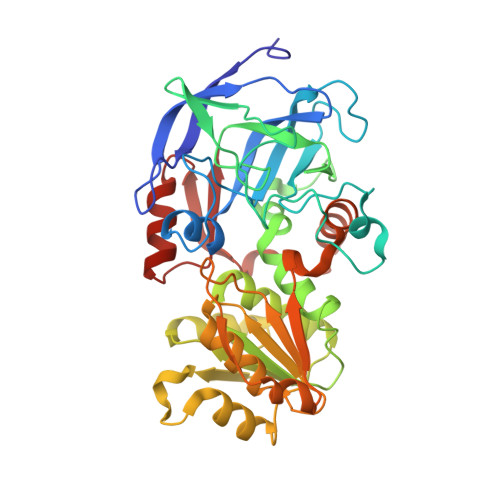Dependence of crystallographic atomic displacement parameters on temperature (25-150 K) for complexes of horse liver alcohol dehydrogenase.
Plapp, B.V., Gakhar, L., Subramanian, R.(2022) Acta Crystallogr D Struct Biol 78: 1221-1234
- PubMed: 36189742
- DOI: https://doi.org/10.1107/S2059798322008361
- Primary Citation of Related Structures:
5KJ1 - PubMed Abstract:
Enzymes catalyze reactions by binding and orienting substrates with dynamic interactions. Horse liver alcohol dehydrogenase catalyzes hydrogen transfer with quantum-mechanical tunneling that involves fast motions in the active site. The structures and B factors of ternary complexes of the enzyme with NAD + and 2,3,4,5,6-pentafluorobenzyl alcohol or NAD + and 2,2,2-trifluoroethanol were determined to 1.1-1.3?? resolution below the `glassy transition' in order to extract information about the temperature-dependent harmonic motions, which are reflected in the crystallographic B factors. The refinement statistics and structures are essentially the same for each structure at all temperatures. The B factors were corrected for a small amount of radiation decay. The overall B factors for the complexes are similar (13-16?? 2 ) over the range 25-100?K, but increase somewhat at 150?K. Applying TLS refinement to remove the contribution of pseudo-rigid-body displacements of coenzyme binding and catalytic domains provided residual B factors of 7-10?? 2 for the overall complexes and of 5-10?? 2 for C4N of NAD + and the methylene carbon of the alcohols. These residual B factors have a very small dependence on temperature and include local harmonic motions and apparently contributions from other sources. Structures at 100?K show complexes that are poised for hydrogen transfer, which involves atomic displacements of ¡«0.3?? and is compatible with the motions estimated from the residual B factors and molecular-dynamics simulations. At 298?K local conformational changes are also involved in catalysis, as enzymes with substitutions of amino acids in the substrate-binding site have similar positions of NAD + and pentafluorobenzyl alcohol and similar residual B factors, but differ by tenfold in the rate constants for hydride transfer.
Organizational Affiliation:
Department of Biochemistry and Molecular Biology, The University of Iowa, Iowa City, IA 52252, USA.




















